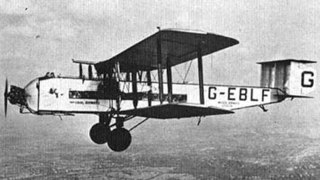
The Aichi D1A or Navy Type 94/96 Carrier Bomber was a Japanese carrier-based dive bomber of the 1930s. A single-engine, two-seat biplane based on the Heinkel He 50, the D1A was produced by Aichi for the Imperial Japanese Navy, remaining in service as a trainer at the time of the attack on Pearl Harbor. The D1A was produced in two variants, the D1A1, and the D1A2.

The Armstrong Whitworth Argosy was a three-engine biplane airliner designed and produced by the British aircraft manufacturer Armstrong Whitworth Aircraft. It was the company's first airliner.

The Armstrong Whitworth A.W.14 Starling was a prototype British single-seat biplane fighter developed for the Royal Air Force in the late 1920s which unsuccessfully competed against the Bristol Bulldog.

The Kugisho B3Y, or Navy Type 92 Carrier Attack Bomber, also popularly titled Yokosuka B3Y, was a Japanese carrier-based torpedo bomber of the 1930s. It was designed by the Naval Air Technical Arsenal at Yokosuka, and while unimpressive during testing, it was ordered into service by the Imperial Japanese Navy and used until replaced by more capable aircraft.

The Kawasaki Army Type 88 Reconnaissance Aircraft was a Japanese single-engined biplane designed for Kawasaki by Richard Vogt. Originally known by its company designation KDA-2, it was accepted by the Imperial Japanese Army as the Type 88 Reconnaissance Aircraft. The Type 88 number was designated for the year the aircraft was accepted, 2588 in the Japanese imperial year calendar, or 1928 in the Gregorian calendar. The basic design was modified into the Type 88 Light Bomber that used in combat over China in the Second Sino-Japanese War. The Type 88 was built in large numbers and remained in service until 1940.

The Mitsubishi K3M was a trainer built by Mitsubishi which was used by the Imperial Japanese Navy in an extremely wide variety of roles, including light transport, liaison aircraft, utility aircraft and occasionally light bomber. Its Allied reporting name was Pine.
The Aichi AB-1 was a result of a 1926 government call for a small, Japanese-built, civil transport biplane able to operate from land or water. It won the contest in both roles but did not reach production as airlines moved from biplanes to monoplanes. Nonetheless, it remained in commercial use well into the 1930s.

The Mitsubishi Army Type 92 Reconnaissance Aircraft (九二式偵察機) was a Japanese short-range reconnaissance aircraft of the 1930s designed by Mitsubishi for the Imperial Japanese Army Air Force. A total of 230 were built, serving between 1933 and 1936. A parasol monoplane, the Type 92 was the first military aircraft powered by an engine both designed and manufactured in Japan to enter service.

The de Havilland DH.56 Hyena was a prototype British army cooperation aircraft of the 1920s. A single-engined biplane, the Hyena was designed against an RAF requirement, but was unsuccessful with only two being built, the Armstrong Whitworth Atlas being preferred.
The Aichi AB-4 was a Japanese flying boat of the 1930s. A single engined biplane, the AB-4 was intended to carry out night reconnaissance for the Imperial Japanese Navy. Six were built and accepted into service as the Experimental 6-Shi Night Reconnaissance Flying boat, three of which were converted to civil transports.

The Fairey Ferret was a 1930s British general-purpose biplane designed and built by the Fairey Aviation Company. It performed well in trials but was not ordered into production.
The Nakajima B3N was a prototype Japanese carrier-based torpedo-bomber aircraft of the 1930s. A single-engined biplane with a crew of three, it was unsuccessful, only two being built.

The Aichi AB-3 was a Japanese ship-board reconnaissance floatplane of the 1930s. The AB-3, a single-seat, single-engined biplane, was designed to equip a light cruiser Ning Hai being built in Japan for the Chinese navy, a single aircraft being accepted by the Chinese.
The Aichi F1A was a prototype Japanese floatplane of the 1930s. A single-engined biplane, the F1A was intended as a short-range observation aircraft suitable for operation off the Imperial Japanese navy's warships, but only two were built, the Mitsubishi F1M being selected instead.

The Aichi E8A was a prototype Japanese reconnaissance floatplane of the 1930s. It was a two-seat single engined biplane built for the Imperial Japanese Navy. Only two were built.
The Kawanishi K-11 was a 1920s Japanese single-seat carrier fighter designed and built by the Kawanishi Aircraft Company to meet an Imperial Japanese Navy requirement. The type did not enter service and only two prototypes were built.
The Aichi AB-2 was a prototype Japanese reconnaissance floatplane of the 1930s. It was a single-engined biplane, of which two examples were built, but no production followed.
The Kawanishi E10K, also known as Kawanishi Type T, Kawanishi Navy Type 94 Transport Seaplane and Kawanishi Navy Experimental 9-Shi Night Reconnaissance Seaplane, was a small Japanese flying boat of the 1930s. It was a single-engined biplane intended to meet a requirement for a night reconnaissance aircraft for the Imperial Japanese Navy, but was not selected for production, the single prototype being converted to a transport and operated as the Navy Type 94 Transport.
The Yokosuka E6Y was a Japanese submarine-based reconnaissance seaplane developed at the Yokosuka Naval Air Technical Arsenal for the Imperial Japanese Navy during the 1920s. The prototype first flew as the Yokosho 2-Go in 1929.

The Mitsubishi Ka-12 or B4M was a Japanese carrier-based torpedo bomber of 1934. Two prototypes were built by Mitsubishi for the Imperial Japanese Navy. A development of the company's 3MT10 of 1932, the design differed primarily in the use of a radial engine and metal wing, which made the whole aircraft significantly lighter and faster. However, the design could not realise its potential as the wing was inefficiently stiff and the B4M was not selected for production. The competing Yokosuka B4Y was chosen to serve on the Navy's aircraft carriers instead.












